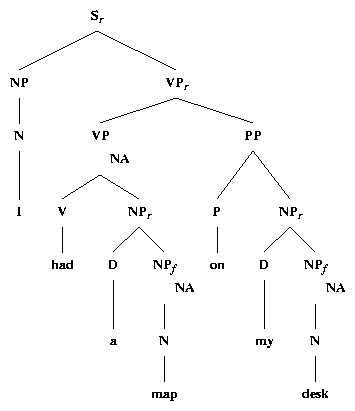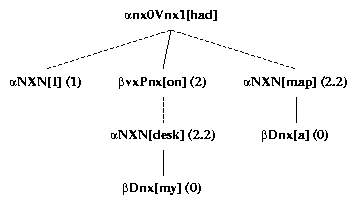



Next: The Grammar Development Environment
Up: System Description
Previous: Tree Database
Once a particular set of lexicalized trees for the sentence have been
selected, XTAG uses an Earley-style predictive left-to-right parsing
algorithm for LTAGs ([#!schabesjoshi88!#,#!schabes90!#]) to find all
derivations for the sentence. The derivation trees and the associated
derived trees can be viewed using the X-interface (see
Table 3.1). The X-interface can also be used to save
particular derivations to disk.
The output of the parser for the sentence I had a map yesterday is
illustrated in Figure 3.2. The parse tree3.3
represents the surface constituent structure, while the derivation tree
represents the derivation history of the parse. The nodes of the derivation
tree are the tree names anchored by the lexical items3.4. The
composition operation is indicated by the nature of the arcs: a dashed line is
used for substitution and a bold line for adjunction. The number beside each
tree name is the address of the node at which the operation took place. The
derivation tree can also be interpreted as a dependency graph with unlabeled
arcs between words of the sentence.
 |
 |
| Parse Tree |
Derivation Tree |
- {Output Structures from the Parser
| Part of Speech |
Description |
| A |
Adjective |
| Ad |
Adverb |
| Comp |
Complementizer |
| D |
Determiner |
| G |
Genitive Noun |
| I |
Interjection |
| N |
Noun |
| P |
Preposition |
| PL |
Particle |
| Punct |
Punctuation |
| V |
Verb |
- {XTAG tagset




Next: The Grammar Development Environment
Up: System Description
Previous: Tree Database
XTAG Project
http://www.cis.upenn.edu/~xtag



